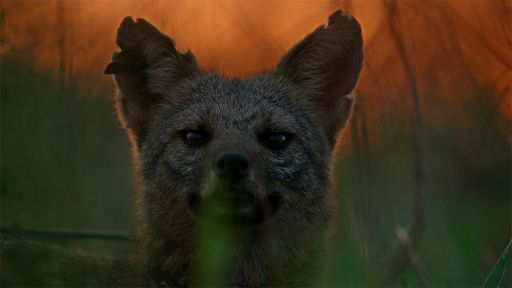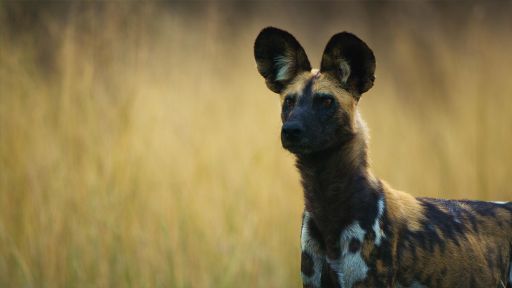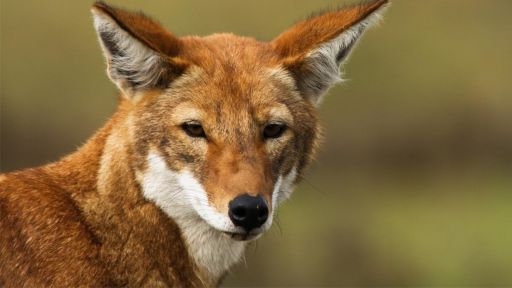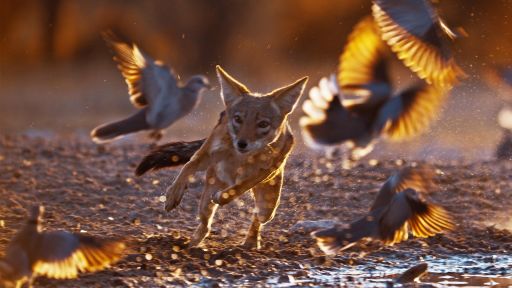Over the course of a year, “Dogs in the Wild” filmmakers filmed over 22 wild dog species across six continents. African Wild Dogs were one of the toughest species to film due to the flooded Okavango River.
Features




(birds cawing) (waves crashing) - Over the space of a year, the Wild Dogs team filmed 22 species across six continents.
One of the toughest dogs to film were the African wild dogs.
(dogs sniffing) (dog sneezing) We'd heard of their incredible voting by sneezing behavior and headed to the Okavango in Botswana.
But every year during the dry season, remarkably the Okavango is flooded, becoming one of the largest inland deltas in the world, a haven for wildlife, a prime hunting ground for wild dogs and a complete nightmare if you're a human in a vehicle.
(vehicle rattling) The Ninja Pack, a part of the Botswana Wild Dog Research Project, and the alpha male is fitted with a tracking collar, which allows the team to pinpoint the dogs.
(tracker beeping) However, keeping up with them is a different story.
- So the dogs, they have crossed the river and we are unable to follow them at the moment.
So we're gonna try and find a way around the river somehow or through the river but obviously, just need to find the right crossing point and hopefully we don't get stuck.
- We've got a plan. - We've got a plan.
(vehicle rumbling) - [Narrator] For three days, they try to cross.
(vehicle reversing) - [Camera Person] Hey.
- [Narrator] Eventually, one vehicle nearly makes it to the other side.
- [Onlookers 1] He's already sort of through the deepest section there.
- [Onlooker 2] Yeah.
- [Onlooker 1] Don't speak too soon.
Oh, I think we spoke too soon.
So I think once, if we ever get out, we really just hope that the dogs come back on this side of the river.
Otherwise, yeah, there is a plan B to maybe, I think we can cross further down river.
It's quite far.
It's quite a drive.
(water bubbling) That's if we get out there.
- [Narrator] The team worked for several hours and finally, the vehicle is free.
(vehicle rumbling) - That was pretty unsuccessful.
Four and a half hours trying to get the one vehicle out.
- [Narrator] Now there's no choice, but take on an arduous six-hour round trip in search of another crossing and the dogs.
- Okay, so the water you see just over there, this looks like our actual crossing point, and we can just hope that this is the only water we need to cross.
(water splashing) - [Narrator] After making it across the water, the team pick up the radio signal from the dogs.
- So after three full days of no dogs and many failed attempts of river crossings, we finally managed to get around but the dog's lying up over there.
Finally.
(dogs yelping) - [Narrator] Filming incredible behaviors took the dedication and hard work of professional filmmakers across the globe.
However, for one wild dog, the best behaviors were captured by amateur naturalists in their own backyard.
In Austin, Texas, Dan Ballard and Jane Hunter have a garden like no other.
Every inch of it is bugged with cameras, (wings fluttering) allowing them to capture incredible footage of a vast array of wildlife, including one very special visitor.
Their land had been a regular backyard, but incredibly, once they no longer had domestic dogs, it allowed a wild one to move in, the elusive gray fox.
(dog running) - I've had pets all my life. I love dogs.
I'm a dog person and yet we've chosen to not have them because wow, it just opened this world up for the wildlife to come in.
- [Narrator] And this sparked the beginning of their incredible wildlife filming setup.
(camera whirring) - We started putting out cameras and one camera led to another camera, which led to a 40 or 50 hardwired cameras.
- [Narrator] These all-seeing eyes, positioned in every corner of their backyard, offer Dan and Jane a 24/7 wildlife surveillance system.
(lively music) And with their kitchen as the nerve center of the operation, they get a highly privileged view into the life of the secretive gray fox.
- The first thing we do when we get up in the morning is we just come and see what's happening now and then we come and see what happened at night.
- The unique camera network made Dan and Jane's backyard the perfect place to film a new generation of pups, and working with camera operator, Shannon van der Veer, they set to work.
- So many times when we're filming wildlife in the wild, we don't have the luxury of CCTV cameras inside their dens and around the area.
(thunder rumbling) - [Narrator] But even with the best setup, you need willing stars - They're sleeping.
Sleeping, sleeping, sleeping.
- [Narrator] Then finally.
- They did it.
They came out.
All three of the pups just came out and they just played.
(pups squeaking) - [Narrator] But this was just the start.
Dan and Jane's super surveillance system and Shannon's expert filming allowed them to capture the gray fox's rarely seen unique climbing behavior, even at night.
(tree rustling) For Dan and Jane, their setup is a long-term project, allowing them to share their backyard wildlife with the world.
- We've seen from our YouTube channel and social media that watching these animals, it's fascinating to people all over the world.
(pups squeaking) - It lets people step right into that world.
If the fox pups are in the den, you know, underground, I feel like I'm under there with them.
Yeah, it's hugely powerful to be able to convey that and show it to the rest of the world.
(wind blowing)
You May Also Like






